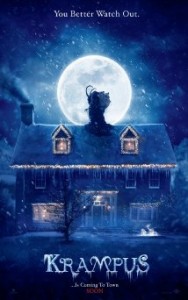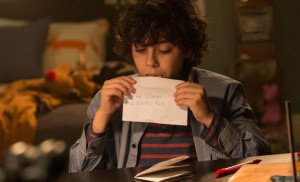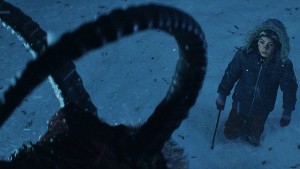 Marking Michael Dougherty’s second feature-length title working as a director, Krampus garnered some attention and anticipation earlier this year. Dougherty’s debut anthology horror film, Trick ‘r Treat (2007), has a loyal following; and for many, Krampus is the litmus test for how adept the young director is at playing in the holiday-horror sandbox. In short, the answer is very adept. Drawing inspiration from Germanic folktales of a horned goat-like figure who punishes bad kids during the Christmas season (a sort of Anti-Clause, if you will), Krampus is a thoroughly enjoyable entry into the Christmas-horror sub-genre.
Marking Michael Dougherty’s second feature-length title working as a director, Krampus garnered some attention and anticipation earlier this year. Dougherty’s debut anthology horror film, Trick ‘r Treat (2007), has a loyal following; and for many, Krampus is the litmus test for how adept the young director is at playing in the holiday-horror sandbox. In short, the answer is very adept. Drawing inspiration from Germanic folktales of a horned goat-like figure who punishes bad kids during the Christmas season (a sort of Anti-Clause, if you will), Krampus is a thoroughly enjoyable entry into the Christmas-horror sub-genre.
Krampus takes us through familiar narrative territory. Max (Emjay Anthony) is your average, run-of-the-mill kid, and his parents, Tom (Adam Scott) and Sarah (Toni Collette) function as everyman characters—windows into the typical upper-class American household. But it’s almost Christmas, and family is coming–those annoying relatives with the obnoxious, misbehaving kids. Of course everyone plays nice at first, but tempers flare at the dinner table, where Max ends up in a fight with his two cousins who were making fun of him because he wrote a letter to Santa. This kerfuffle leads Max to destroy his letter and send it flying out the window in tiny, torn shreds. As a storm blows in, leaving the house without electricity, a literal and metaphorical darkness envelops the family. Max has unwittingly summoned Krampus.
 In many ways, Krampus is a throwback movie, with nods to Joe Dante’s Gremlins (1984) being among the most noticeable. Both films are replete with cute-yet-deadly antagonists, and a young boy’s mistake is the source of much woe. Additionally, many of the exterior shots of the family’s house—a sprawling mansion bedecked with Christmas lights and surrounded by ominous-looking trees with branches reaching out like claws—harkens back to the McCallister house in Chris Columbus’ Home Alone (1990). Tonally, it is very similar to the Scandinavian gem, Rare Exports (2010), which you really must see if you are a fan of the genre. In other words, Krampus is a very self-aware film; it pays homage to it predecessors, and it never falls into the trap of taking itself too seriously. Moreover, it is Dougherty’s deft balancing of comedic and horror elements that keeps audiences engaged. Like the aforementioned folktale upon which it is based, however, Krampus is ultimately a morality tale, suggesting that if we set our affections upon the wrong object, the very thing we love the most will inevitably be the source of our destruction.
In many ways, Krampus is a throwback movie, with nods to Joe Dante’s Gremlins (1984) being among the most noticeable. Both films are replete with cute-yet-deadly antagonists, and a young boy’s mistake is the source of much woe. Additionally, many of the exterior shots of the family’s house—a sprawling mansion bedecked with Christmas lights and surrounded by ominous-looking trees with branches reaching out like claws—harkens back to the McCallister house in Chris Columbus’ Home Alone (1990). Tonally, it is very similar to the Scandinavian gem, Rare Exports (2010), which you really must see if you are a fan of the genre. In other words, Krampus is a very self-aware film; it pays homage to it predecessors, and it never falls into the trap of taking itself too seriously. Moreover, it is Dougherty’s deft balancing of comedic and horror elements that keeps audiences engaged. Like the aforementioned folktale upon which it is based, however, Krampus is ultimately a morality tale, suggesting that if we set our affections upon the wrong object, the very thing we love the most will inevitably be the source of our destruction.
In a sense, then, the film can be read as a critique of the modern consumerist culture. Krampus opens with a slow-mo Black Friday sequence. With Andy Williams’ “It’s the Most Wonderful Time of the Year” playing at full volume, employees dive for cover as mobs of people storm into the store. Crazed shoppers push and pull, fight and shove to claim their precious electronic treasures. The juxtaposition between the visual and the aural creates an comedic irony, and it also serves as a scathing indictment of consumerism, greed, and excess. Later, inside Max’s house, a reporter on a television playing in the background talks about Christmas as a marketing ploy.
 As Krampus transitions into horror mode, the subtext takes on a more menacing form as well. While the titular Krampus is indeed a horrifying chieftain of Christmas dread, it is his minions who solidify the film’s critique of consumerist culture. Krampus employs (minor spoilers here) sinister gingerbread cookies, evil angel decorations, and a flesh-eating jack-in-the-box—almost all of which come disguised as Christmas presents—to do his bidding. Quite literally, the objects of our coveting, desire, and affection are transformed into monsters that threaten to overtake and destroy us.
As Krampus transitions into horror mode, the subtext takes on a more menacing form as well. While the titular Krampus is indeed a horrifying chieftain of Christmas dread, it is his minions who solidify the film’s critique of consumerist culture. Krampus employs (minor spoilers here) sinister gingerbread cookies, evil angel decorations, and a flesh-eating jack-in-the-box—almost all of which come disguised as Christmas presents—to do his bidding. Quite literally, the objects of our coveting, desire, and affection are transformed into monsters that threaten to overtake and destroy us.
At the very least, then, Krampus invites us to consider what—or whom—we truly love this Christmas season.
